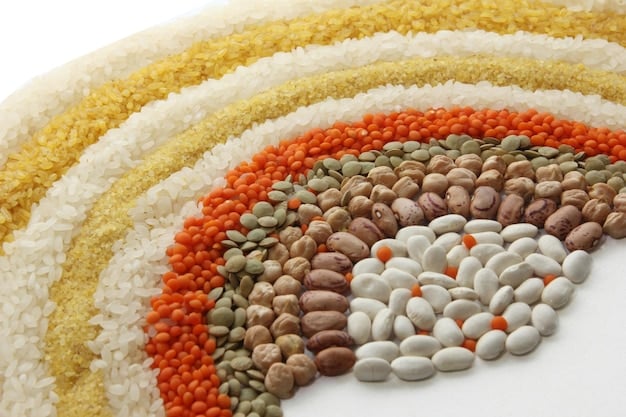Nutrition Plan for Endomorphs: Fat Loss & Muscle Gain Guide

Achieving optimal body composition for endomorphs, characterized by a natural propensity to store fat, requires a meticulously designed nutrition plan for endomorphs: how to lose fat and build muscle effectively that prioritizes complex carbohydrates, lean proteins, healthy fats, and strict portion control to regulate energy balance and hormonal responses.
Are you an endomorph struggling to shed stubborn fat and build lean muscle? If so, you’re not alone. Navigating the complexities of body types and metabolism can be challenging, but with a strategic nutrition plan for endomorphs: how to lose fat and build muscle effectively, you can unlock your body’s full potential.
Understanding the Endomorph Body Type
The endomorph body type is one of the three somatotypes, alongside ectomorphs and mesomorphs, each with distinct metabolic and physiological characteristics. Endomorphs are typically characterized by a larger bone structure, a rounder body shape, and a propensity to store fat. This genetic predisposition means their bodies are generally more efficient at converting carbohydrates into fat, making fat loss a more challenging endeavor compared to other body types.
This efficiency in fat storage isn’t necessarily a disadvantage; historically, it might have been an evolutionary adaptation for survival during periods of food scarcity. However, in modern environments with abundant food, it often translates into easier weight gain and slower weight loss. Understanding this fundamental aspect is the first step in formulating an effective strategy.
Metabolic Profile of Endomorphs
Endomorphs often exhibit a slower metabolism, meaning their bodies burn fewer calories at rest. This can be attributed to various factors, including genetic makeup and a higher percentage of body fat, which is less metabolically active than muscle tissue. Furthermore, endomorphs may experience higher insulin sensitivity issues, leading to greater fat storage when consuming high amounts of carbohydrates, particularly refined ones.
Their bodies tend to respond well to fat and protein as primary energy sources, rather than relying heavily on carbohydrates. This is a crucial insight that underpins the dietary recommendations for this body type. The goal is to optimize nutrient intake to encourage fat burning while preserving muscle mass.
Common Challenges for Endomorphs
- Increased tendency to store fat, particularly in the lower body and abdomen.
- Slower metabolism, making calorie deficit difficult to achieve without significant effort.
- Potential for greater challenges with insulin sensitivity and blood sugar regulation.
- Difficulty in building lean muscle mass due to higher body fat percentages.
Addressing these challenges requires a methodical approach that goes beyond generic dietary advice. It demands a personalized nutrition plan that takes into account the endomorph’s unique metabolic responses. The objective is to create a sustainable eating pattern that supports both fat loss and muscle development, rather than restrictive diets that are often difficult to maintain long-term.
Ultimately, recognizing the specific attributes of an endomorph’s metabolism is paramount. This awareness allows for a targeted approach to diet and exercise, transforming perceived weaknesses into strengths and paving the way for sustainable body composition improvements. It’s about working with your body, not against it, to achieve health and fitness goals.
Macronutrient Breakdown for Endomorphs
The strategic distribution of macronutrients—proteins, carbohydrates, and fats—is the cornerstone of an effective nutrition plan for endomorphs. Given their metabolic characteristics, a subtle recalibration of these ratios can significantly impact fat loss and muscle gain. The aim is to balance energy sources in a way that minimizes fat storage while providing sufficient fuel for activity and muscle repair.
For endomorphs, the traditional “eat less, move more” adage often falls short without a nuanced understanding of how their bodies process different macronutrients. Prioritizing certain macros over others can lead to better hormonal responses, improved satiety, and more efficient fat burning.
Protein: The Foundation of Muscle and Satiety
Protein is arguably the most critical macronutrient for endomorphs. A higher protein intake supports muscle preservation during periods of calorie deficit, which is essential for maintaining a healthy metabolic rate. Moreover, protein has a high thermic effect, meaning your body expends more energy to digest it compared to fats or carbohydrates. This contributes to a slight increase in calorie expenditure.
Lean protein sources also help promote satiety, reducing cravings and overeating. This is particularly beneficial for endomorphs who may struggle with managing appetite due to metabolic fluctuations. Aim for protein in every meal to keep hunger at bay and support muscle protein synthesis.
- Sources: Chicken breast, turkey, lean beef, fish (salmon, cod), eggs, Greek yogurt, cottage cheese, tofu, legumes.
- Target Intake: Approximately 0.8-1 gram of protein per pound of body weight.
Carbohydrates: Strategic and Controlled
While carbohydrates are often viewed with caution by endomorphs, they are not to be entirely eliminated. The key lies in strategic selection and portion control. Endomorphs generally respond better to lower carbohydrate intake, focusing on complex, whole-food sources with a high fiber content. These types of carbohydrates provide sustained energy, prevent rapid blood sugar spikes, and improve insulin sensitivity.
Timing your carbohydrate intake can also be beneficial. Consuming the majority of your carbohydrates around your workouts can help fuel exercise and replenish glycogen stores without excessive fat storage. Avoid refined sugars, processed grains, and high-fructose corn syrup, which can exacerbate insulin resistance and promote fat accumulation.

- Sources: Oats, quinoa, brown rice, sweet potatoes, whole-grain bread (in moderation), a wide variety of fibrous vegetables (broccoli, spinach, bell peppers).
- Target Intake: Begin with 20-30% of total daily calories, adjusting based on individual response and activity level.
Fats: Healthy and Essential
Healthy fats are crucial for hormone production, nutrient absorption, and overall cellular function. For endomorphs, incorporating healthy fats can also contribute to satiety, compensating for a reduced carbohydrate intake. However, portion control remains vital as fats are calorie-dense.
Prioritize monounsaturated and polyunsaturated fats, including omega-3 fatty acids, which have anti-inflammatory properties and support metabolic health. Avoid trans fats and limit saturated fats, as they can negatively impact cardiovascular health and potentially contribute to insulin resistance.
- Sources: Avocados, nuts (almonds, walnuts), seeds (chia, flax), olive oil, fatty fish (salmon, mackerel).
- Target Intake: Approximately 30-40% of total daily calories, ensuring a balance of beneficial fats.
By carefully modulating these macronutrient ratios, endomorphs can create a diet that supports their metabolic needs, promoting efficient fat loss while fostering muscle development. This approach moves beyond generic dietary advice, offering a tailored strategy for sustainable results.
Meal Timing and Frequency
Beyond what you eat, when you eat also plays a significant role in an endomorph’s nutrition plan. Strategic meal timing and frequency can help manage blood sugar levels, control hunger, and optimize nutrient absorption, all crucial factors for effective fat loss and muscle gain. The goal is to keep your metabolism active and stable throughout the day, preventing drastic energy dips that can lead to unhealthy snacking.
For endomorphs, who often struggle with insulin sensitivity, consistent meal patterns can mitigate large insulin spikes, which in turn reduces the likelihood of fat storage. It’s not necessarily about eating constantly, but rather about creating a predictable rhythm for your body.
Frequent, Smaller Meals
Instead of three large meals, endomorphs often benefit from consuming 4-6 smaller meals throughout the day. This approach helps stabilize blood sugar levels, maintains a steady supply of nutrients, and can prevent excessive hunger that leads to overeating. Each meal should ideally include a balance of protein, complex carbohydrates, and healthy fats to maximize satiety and nutrient utilization.
Smaller, more frequent meals can also help keep your metabolic furnace stoked, ensuring a more consistent calorie burn. However, it’s vital that the total daily caloric intake remains within your target for fat loss, as frequent eating doesn’t give you license to consume more calories overall.
Carbohydrate Timing
One of the most effective strategies for endomorphs is to time their carbohydrate intake around periods of high energy expenditure. This typically means consuming the majority of your daily carbohydrates before and after your workouts. Pre-workout carbohydrates provide the necessary fuel for intense training sessions, while post-workout carbohydrates help replenish glycogen stores in muscles, aiding recovery and muscle growth.
During other parts of the day, especially in the evening, it’s generally advisable for endomorphs to reduce carbohydrate intake and focus more on lean protein and fibrous vegetables. This can help prevent excess carbohydrates from being stored as fat overnight when metabolic activity is naturally lower.
Importance of Breakfast
Starting the day with a high-protein, moderate-fat breakfast is crucial for endomorphs. This meal helps kickstart your metabolism, reduces morning cravings, and sets a positive tone for blood sugar regulation throughout the day. Avoid sugary cereals or pastries, which can lead to rapid blood sugar spikes and subsequent crashes.
A breakfast rich in protein helps maintain satiety for longer, preventing the mid-morning hunger pangs that often lead to poor snack choices. Consider options like eggs with vegetables, Greek yogurt with berries (in moderation), or a protein smoothie.
Nighttime Nutrition
As mentioned, nighttime eating for endomorphs should primarily focus on protein and healthy fats, with minimal carbohydrates. A protein shake or some cottage cheese before bed can provide amino acids for muscle repair and growth during sleep without contributing to fat storage. This helps prevent muscle breakdown and supports recovery.
Avoid heavy, carbohydrate-laden meals late in the evening. This practice can burden your digestive system and potentially lead to glucose being stored as fat, given the body’s decreased need for immediate energy during sleep.
Adopting a disciplined but flexible approach to meal timing and frequency can empower endomorphs to better manage their weight and body composition. It’s about optimizing your body’s natural rhythms to your advantage, creating a more efficient system for fat metabolism and muscle development.
Food Selection: What to Prioritize and What to Avoid
The success of any nutrition plan for endomorphs: how to lose fat and build muscle effectively hinges on meticulous food selection. For endomorphs, who are genetically prone to storing body fat and potentially dealing with insulin sensitivity, choosing the right foods is not just about calorie counting but about making smart choices that support their unique metabolism. This means focusing on nutrient-dense, whole foods that promote satiety and stable blood sugar levels, while strictly limiting processed items that can sabotage progress.
Every food choice represents an opportunity to either nourish your body or contribute to the metabolic challenges endomorphs often face. Therefore, a clear understanding of foods to embrace and those to avoid is paramount.
Foods to Prioritize
Your plate should be predominantly filled with lean proteins, non-starchy vegetables, and healthy fats. These food groups work synergistically to provide sustained energy, promote muscle growth, and maintain stable blood sugar levels without causing excessive insulin responses.
- Lean Proteins: The bedrock of muscle building and satiety. Prioritize sources like chicken breast, turkey, fish (salmon, tuna, cod), eggs, and lean cuts of beef or pork. Plant-based proteins such as tofu, tempeh, and lentils are also excellent choices.
- Non-Starchy Vegetables: Abundant in fiber, vitamins, and minerals, these vegetables are low in calories and carbohydrates, making them ideal for endomorphs. Include plenty of broccoli, spinach, kale, bell peppers, asparagus, and green beans in your daily meals. Their high fiber content aids digestion and contributes to a feeling of fullness.
- Healthy Fats: Essential for hormonal health and sustained energy. Incorporate avocados, nuts (almonds, walnuts, pecans – in moderation due to calorie density), seeds (chia, flax, hemp), olive oil, and coconut oil. These fats help with satiety and provide crucial fat-soluble vitamins.
- Complex Carbohydrates (Limited and Timed): While overall carbohydrate intake is lower for endomorphs, smart choices are still vital. Focus on sources like quinoa, brown rice, oats, and sweet potatoes, consuming them predominantly around your workout times to fuel activity and aid recovery.
Foods to Moderately Consume
Some foods can be included in moderation, provided they are whole and unprocessed, and fit within your overall calorie and macronutrient targets. These typically include fruits and certain dairy products.
- Fruits: While healthy, fruits contain natural sugars. Opt for berries (raspberries, blueberries, strawberries) which are lower in sugar and higher in fiber. Consume them in moderation, perhaps post-workout or as a small snack.
- Dairy Products: Unsweetened Greek yogurt, cottage cheese, and low-fat milk can be good sources of protein and calcium. However, some endomorphs may find dairy exacerbates digestive issues or stalls weight loss, so individual tolerance should be assessed.
Foods to Avoid or Strictly Limit
These foods are typically high in refined sugars, unhealthy fats, and processed ingredients that can lead to blood sugar spikes, increased fat storage, and inflammation, severely hindering an endomorph’s progress.
- Refined Sugars and Sweeteners: Candy, pastries, sodas, sugary juices, and most processed desserts. These cause rapid insulin spikes and are readily converted to fat.
- Processed Grains: White bread, white pasta, most breakfast cereals, and baked goods made with refined flour. They offer little nutritional value and can negatively impact blood sugar.
- Trans Fats and Excessive Saturated Fats: Fried foods, fast food, many snack foods, and heavily processed meats. These contribute to inflammation and can impair metabolic health.
- Excessive Alcohol: Alcohol contains empty calories and can disrupt fat metabolism. Its consumption should be minimized, especially during a fat loss phase.
Ultimately, a disciplined approach to food selection, emphasizing nutrient density and avoiding metabolic disruptors, is foundational. By making informed choices, endomorphs can better manage their energy levels, blood sugar, and body composition, paving the way for sustainable health and fitness achievements.
Hydration and Supplementation
Often overlooked, proper hydration and strategic supplementation can significantly enhance a nutrition plan for endomorphs: how to lose fat and build muscle effectively. While whole foods form the bedrock of your diet, water is essential for every bodily function, and certain supplements can help bridge nutritional gaps, optimize performance, and support recovery, especially for a body type focused on metabolic efficiency and muscle preservation.
These elements, although secondary to a well-structured diet and exercise regimen, can provide crucial support, particularly during the demanding phases of fat loss and muscle building.
The Crucial Role of Hydration
Water is indispensable for metabolic processes, nutrient transport, and detoxification. For endomorphs, staying adequately hydrated can also aid in appetite control and improve the sensation of fullness, potentially reducing overall calorie intake. Dehydration can lead to fatigue, decreased metabolic rate, and impaired exercise performance, all of which hinder progress.
Aim for at least 8-10 glasses of water daily, and even more if you’re exercising intensely or in a hot climate. Don’t wait until you’re thirsty; by then, you’re already mildly dehydrated. Carrying a reusable water bottle can serve as a constant reminder to sip throughout the day.
- Benefits: Supports metabolism, aids digestion, transports nutrients, helps control appetite, and flushes out toxins.
- Tip: Infuse water with lemon, cucumber, or mint for flavor without added sugars.
Strategic Supplementation for Endomorphs
Supplements are not magic pills, but they can be valuable tools when used judiciously to complement a solid diet and training program. For endomorphs, the focus should be on supplements that support metabolism, improve insulin sensitivity, aid muscle recovery, and ensure adequate micronutrient intake.
Protein Supplements
Protein powders (whey, casein, or plant-based) are convenient for meeting daily protein targets, especially around workouts or as a quick meal replacement. They help with muscle repair and satiety without adding excessive carbohydrates or fats.
Creatine Monohydrate
Creatine is one of the most researched and effective supplements for increasing strength, power, and muscle mass. While it doesn’t directly aid fat loss, increased muscle mass boosts metabolism, indirectly supporting fat burning. It’s safe and beneficial for most individuals engaged in resistance training.
Omega-3 Fatty Acids (Fish Oil)
Given the importance of healthy fats for endomorphs, omega-3 supplements can be beneficial, especially if dietary intake from fatty fish is insufficient. Omega-3s have anti-inflammatory properties, support cardiovascular health, and may improve insulin sensitivity, all of which are advantageous for endomorphs.
Vitamin D
Many individuals are deficient in Vitamin D, which plays a critical role in bone health, immune function, and potentially metabolic regulation. Supplementation might be necessary, especially for those with limited sun exposure.
Fiber Supplements
If your dietary fiber intake is suboptimal, a fiber supplement (e.g., psyllium husk) can help. Fiber is crucial for digestive health, blood sugar control, and satiety, all important aspects for endomorphs managing their weight.

Probiotics
A healthy gut microbiome is increasingly linked to metabolic health and weight management. Probiotic supplements can support gut flora, which may indirectly influence how your body processes nutrients and stores fat.
Before introducing any new supplement, it’s always advisable to consult with a healthcare professional or a registered dietitian. They can provide personalized advice based on your individual health status, dietary needs, and fitness goals. Supplements should always augment, not replace, a balanced and nutrient-rich diet.
Exercise & Lifestyle Factors for Endomorphs
While nutrition takes center stage in an endomorph’s journey towards fat loss and muscle gain, it is profoundly complemented by specific exercise strategies and overall lifestyle factors. For endomorphs, who might find weight management more challenging due to their metabolic predispositions, a holistic approach that integrates mindful movement and healthy habits is non-negotiable. This synergy ensures that dietary efforts are amplified, leading to more sustainable and significant results.
Focusing solely on diet without incorporating physical activity or neglecting other lifestyle elements can limit progress and make the journey feel more arduous. The goal is to build a comprehensive routine that supports both physiological and psychological well-being.
Exercise Strategies
The ideal exercise regimen for endomorphs combines resistance training with regular cardiovascular activity. This combination targets fat loss while simultaneously building and preserving metabolically active muscle mass.
Resistance Training: Building the Metabolic Engine
Resistance training is paramount for endomorphs. Muscle tissue burns more calories at rest than fat tissue, meaning an increase in lean muscle mass will naturally boost your basal metabolic rate (BMR). This is particularly beneficial for endomorphs with naturally slower metabolisms.
- Frequency: Aim for 3-4 days of full-body or split resistance training per week.
- Intensity: Focus on compound movements (squats, deadlifts, bench presses, rows) that engage multiple muscle groups and elicit a higher caloric expenditure. Lift challenging weights that allow for 8-12 repetitions per set, leading to muscle fatigue.
- Progressive Overload: Continuously challenge your muscles by gradually increasing weight, reps, or sets to ensure ongoing muscle adaptation and growth.
Cardiovascular Training: The Fat-Burning Accelerator
Cardio helps create a calorie deficit and improves cardiovascular health. For endomorphs, high-intensity interval training (HIIT) can be particularly effective, as it boosts post-exercise oxygen consumption (EPOC), leading to a higher calorie burn even after the workout is complete. However, steady-state cardio also has its place for overall fitness and recovery.
- HIIT: Incorporate 2-3 sessions per week. Examples include sprint intervals, cycling intervals, or circuit training with minimal rest.
- Steady-State Cardio: Include 2-3 sessions of moderate-intensity cardio (e.g., brisk walking, jogging, elliptical) for 30-45 minutes. This aids in recovery and further contributes to calorie expenditure.
Lifestyle Factors: Beyond Diet and Exercise
Optimal health and body composition are not solely about what you eat and how you move; sleep, stress management, and consistency play equally vital roles, especially for endomorphs.
Adequate Sleep
Sleep profoundly impacts hormones that regulate appetite (ghrelin and leptin) and metabolism (insulin, cortisol). Lack of sleep can disrupt these hormones, leading to increased cravings, impaired insulin sensitivity, and a greater tendency to store fat. Aim for 7-9 hours of quality sleep per night.
Stress Management
Chronic stress elevates cortisol levels, a hormone that can promote fat storage, particularly in the abdominal area. Finding effective stress-reduction techniques—such as meditation, yoga, mindfulness, or hobbies—is crucial for an endomorph’s success.
Consistency and Patience
Results won’t happen overnight. Embracing consistency in both diet and exercise is far more important than sporadic bursts of intense effort. Endomorphs need to be patient and committed, understanding that their body type may require a more disciplined and sustained approach to achieve desired outcomes. Progress should be tracked not just by the scale, but also by body measurements, photos, and energy levels.
By integrating these exercise strategies and lifestyle factors, endomorphs can create a robust framework that supports their nutritional efforts, paving the way for effective fat loss, robust muscle gain, and lasting health improvements. It is about creating a symbiotic relationship between fuel, movement, and recovery.
Tracking Progress and Adjusting Your Plan
A static nutrition and exercise plan, however well-designed, will eventually lose effectiveness. For endomorphs, given their unique metabolic profile and propensity for fat storage, continuous tracking and strategic adjustment of their plan are not just beneficial, but absolutely essential. Your body is dynamic, and as it adapts, your approach must evolve to continue pushing towards your goals of fat loss and muscle gain. This iterative process ensures you remain on the path to sustainable results.
Without monitoring and modification, even the most diligent efforts can plateau. It’s about listening to your body, interpreting its signals, and making informed decisions based on concrete data.
Methods for Tracking Progress
The scale is just one tool and often an unreliable one in isolation, especially when you are building muscle while losing fat. A multi-faceted approach to tracking provides a more accurate picture of your progress.
- Body Measurements: Regularly measure key body circumferences (waist, hips, chest, arms, thighs). Reductions in these measurements often indicate fat loss even if the scale doesn’t move due to muscle gain.
- Progress Photos: Take photos every 2-4 weeks. Visual changes can be highly motivating and reveal transformations that numbers might miss. Use consistent lighting and angles.
- Performance Metrics: Track your strength in the gym (how much weight you lift, reps, sets) and your endurance in cardio. Improvements here indicate muscle gain and improved fitness.
- Food and Exercise Journal: Logging your food intake and workouts can reveal patterns, identify problem areas, and help you determine what works best for your body. This also highlights adherence to your plan.
- Body Composition Analysis: Tools like DEXA scans, bioelectrical impedance analysis (BIA), or even basic calipers can provide estimates of body fat percentage versus lean mass. While not always perfectly accurate, they offer valuable trends over time.
When and How to Adjust
Adjustments should be data-driven and gradual. Drastic changes can disrupt your system and make it harder to pinpoint what caused a particular outcome.
Plateau Management
A plateau occurs when progress stalls for 2-3 consecutive weeks despite consistent adherence. This is a sign your body has adapted, and it’s time for a change.
- Calorie Adjustment: If fat loss stalls, slightly reduce your calorie intake (e.g., by 100-200 calories per day) or increase activity. If muscle gain stalls, slightly increase calories.
- Macronutrient Ratios: Experiment with minor shifts in your macro ratios. For instance, slightly reducing carbohydrates and increasing fats, or vice-versa, to see how your body responds.
- Training Program Changes: Alter your exercise routine. This could mean changing exercises, increasing intensity, varying rep ranges, or trying a different workout split.
Responding to Body Signals
Pay attention to how your body feels. Are you consistently fatigued? Are your cravings intense? Are you recovering well from workouts?
- Low Energy/High Fatigue: Could indicate insufficient calories, especially carbohydrates. Consider a refeed day or slight caloric increase.
- Persistent Hunger: Might suggest insufficient protein or fiber. Re-evaluate your food choices for satiety.
- Poor Recovery: Could be due to inadequate sleep, insufficient protein, or overtraining. Adjust training volume or prioritize rest.
The Importance of Patience and Consistency
Endomorphs, perhaps more than other body types, require immense patience. Their bodies are efficient at retaining energy, so progress might appear slower. Consistency over intensity in the long run yields the best results. Celebrate small victories and view setbacks as learning opportunities rather than failures.
Remember that the journey is continuous. Regular assessment and flexible adaptation of your nutrition and exercise plan will ensure long-term success in achieving and maintaining your desired body composition. This personalized, responsive approach transforms generic advice into a highly effective strategy tailored to your unique metabolic needs.
| Key Point | Brief Description |
|---|---|
| 💪 Macronutrient Focus | Prioritize high protein, moderate healthy fats, and controlled complex carbs. |
| ⏰ Meal Timing |
Smaller, frequent meals + carb timing around workouts help regulate blood sugar. |
| 🍎 Food Selection | Emphasis on lean proteins, non-starchy veggies, healthy fats; limit processed foods. |
| 🏋️ Exercise & Lifestyle | Combine resistance training with HIIT; prioritize sleep and stress management. |
Frequently Asked Questions About Endomorph Nutrition
▼
No, endomorphs do not need to completely avoid carbohydrates. The key is to consume them strategically, focusing on complex, high-fiber sources like oats, quinoa, and sweet potatoes. Timing carbohydrate intake primarily around workouts can help fuel exercise and aid recovery without promoting excess fat storage.
▼
Endomorphs often benefit from eating 4-6 smaller, balanced meals throughout the day rather than three large ones. This approach helps stabilize blood sugar levels, maintains a steady metabolism, and can better control hunger, preventing overeating and supporting sustained energy levels.
▼
A combination of resistance training and high-intensity interval training (HIIT) is highly effective. Resistance training builds metabolically active muscle, boosting resting metabolism, while HIIT is excellent for burning fat and improving cardiovascular fitness efficiently. Consistent moderate-intensity cardio can also be beneficial.
▼
Intermittent fasting can be beneficial for some endomorphs by helping to control calorie intake and improve insulin sensitivity. However, individual responses vary. It’s essential to ensure nutrient needs are met during eating windows and to monitor how your body responds to determine if it’s a sustainable practice for your specific metabolism and lifestyle.
▼
Sleep and stress management are critically important. Poor sleep can disrupt hormones that regulate appetite and metabolism (ghrelin, leptin, insulin), while chronic stress elevates cortisol, both of which can promote fat storage and hinder fat loss. Prioritizing 7-9 hours of quality sleep and managing stress are crucial for optimal results.
Conclusion
Navigating the journey of fat loss and muscle gain as an endomorph requires a nuanced and individualized strategy, moving beyond one-size-fits-all advice. By deeply understanding your body’s inherent tendencies—its efficiency in storing fat and its metabolic pace—you can tailor a comprehensive approach that transforms these characteristics into strengths. The core of this strategy lies in a meticulously crafted nutrition plan that prioritizes protein and healthy fats, strategically limits and times complex carbohydrates, and steers clear of processed foods and refined sugars. This dietary blueprint, when consistently applied, helps manage blood sugar levels, optimizes satiety, and fosters an environment conducive to burning fat while preserving lean muscle mass.
Furthermore, the success of an endomorph’s transformation extends beyond the plate to encompass a synergistic integration of targeted exercise and mindful lifestyle choices. Resistance training becomes your best ally in boosting a naturally slower metabolism through muscle growth, while a blend of HIIT and steady-state cardio amplifies fat burning. Equally vital are the often-underestimated factors of adequate sleep and effective stress management, both of which profoundly influence hormonal balance and metabolic function. Finally, the journey is an ongoing dialogue with your body; continuous tracking of progress through various metrics and a willingness to compassionately adjust your plan in response to your body’s signals are paramount for overcoming plateaus and achieving sustainable, long-term success. Embrace patience, celebrate small victories, and commit to the process, because with the right focus, effective fat loss and robust muscle gain for endomorphs are not just aspirational but entirely achievable.





